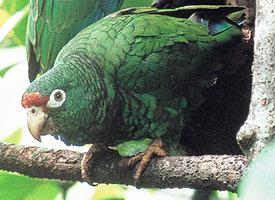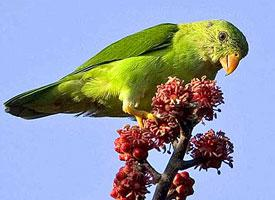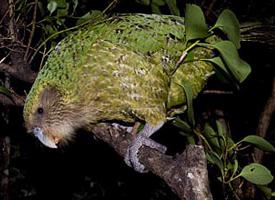
Poids et mesures
| Hauteur au garrot | de 28 à 30 cm |
|---|
Statut de conservation
| Menacé |
Description de l'animal
The Puerto Rican Amazon, scientifically known as Amazona vittata, is a captivating and critically endangered species of parrot native to the island of Puerto Rico. This vibrant bird is distinguished by its predominantly green plumage, which serves as excellent camouflage in its natural habitat. The bird's body is adorned with feathers that exhibit various shades of green, providing a mesmerizing effect when observed in sunlight. Key features that set the Puerto Rican Amazon apart include a red forehead, which adds a striking contrast to its green body, and white rings around its eyes that give it a distinctive appearance. The bird's bill is robust and curved, designed perfectly for cracking nuts and seeds, which form a significant part of its diet.Adults typically reach a length of about 28 to 30 centimeters, making them a medium-sized parrot. Despite their relatively small size, they possess a strong presence, thanks in part to their vivid coloring and the loud, distinctive calls they use to communicate with one another. These calls range from squawks to more melodious sounds and play a crucial role in the social structure of the species, aiding in bonding pairs and signaling distress or alert.
The Puerto Rican Amazon is a highly social creature, forming strong pair bonds that are believed to last a lifetime. They are known to live in small groups, especially outside the breeding season, and exhibit complex behaviors that include mutual preening and cooperative feeding. This social structure is vital not only for their survival but also for the rearing of their young.
Breeding takes place once a year, with nests typically located in the hollows of large trees. The female lays between two to four eggs, which she incubates for around 24 to 28 days. During this time, the male plays a crucial role in feeding the female and, later, the chicks. The young are altricial, meaning they are born blind and without feathers, completely dependent on their parents for warmth and nourishment. They fledge the nest after about 60 to 65 days but remain dependent on their parents for several weeks thereafter.
Historically, the Puerto Rican Amazon inhabited a wide range of ecosystems across Puerto Rico, from coastal regions to mountainous areas. However, its population has drastically declined due to a combination of habitat destruction, introduced predators, and illegal capture for the pet trade. Today, their existence is confined to a few protected areas, where conservation efforts are underway to ensure their survival.
Conservation programs for the Puerto Rican Amazon have included habitat restoration, the establishment of new wild populations through the release of captive-bred individuals, and rigorous monitoring to prevent poaching. These efforts have been critical in preventing the species' extinction and represent a beacon of hope for its future.
In summary, the Puerto Rican Amazon is a strikingly beautiful and highly social bird, whose existence is precariously balanced on the edge of extinction. Through concerted conservation efforts, there is hope that this unique species will continue to be a part of Puerto Rico's natural heritage for generations to come.
Animaux similaires
Nouvelles photos d'animaux
Top 10 des animaux
- Dolphin gull (Leucophaeus scoresbii)
- Diana monkey (Cercopithecus diana)
- Moustached guenon (Cercopithecus cephus)
- Galápagos tortoise (Geochelone nigra complex)
- Stone loach (Barbatula barbatula)
- Japanese macaque (Macaca fuscata)
- Russian tortoise (Testudo horsfieldii)
- Greek tortoise (Testudo graeca)
- Common flying dragon (Draco volans)
- Vendace (Coregonus albula)


